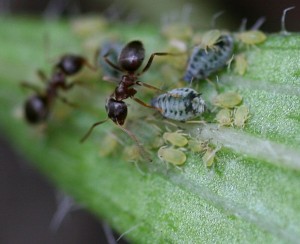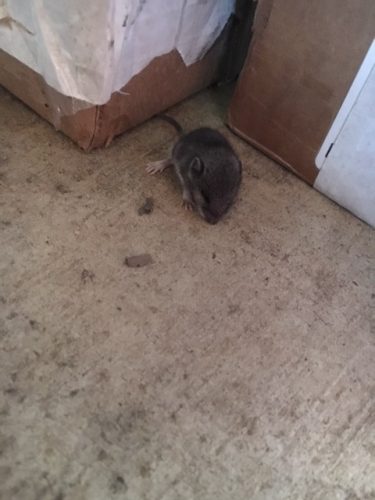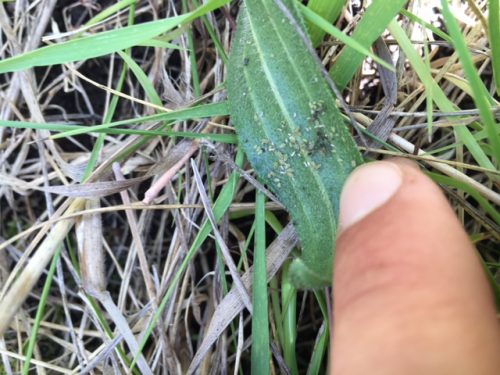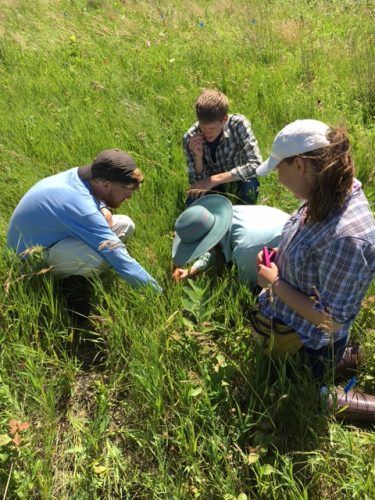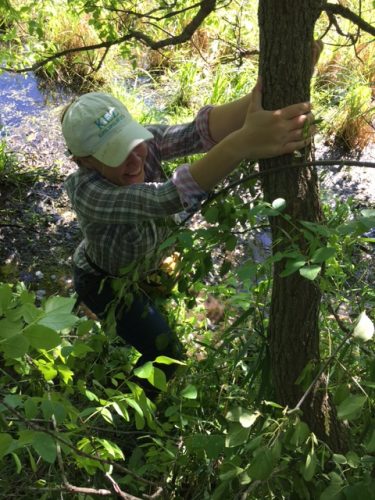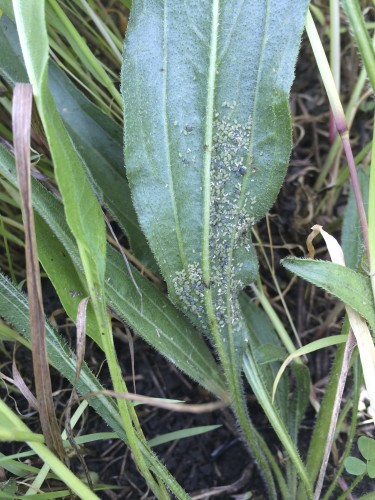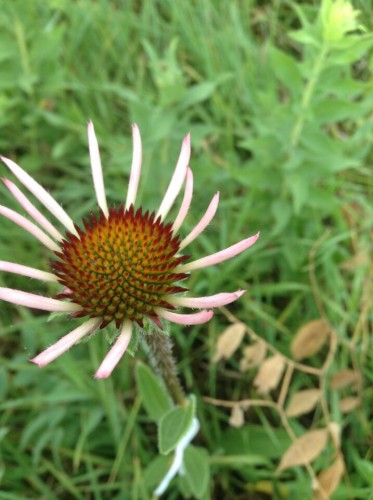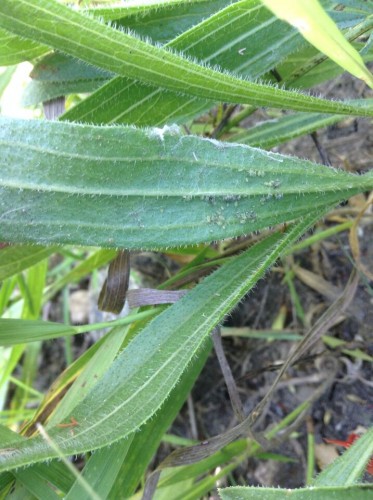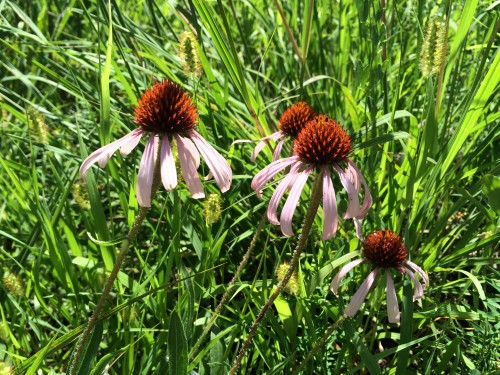|
|
 Aphids on an Echinacea leaf This summer Team Echinacea continued adding and excluding aphids to plants in the experiment that Katherine Muller started. In 2011, Katherine Muller designated a sample of 100 Echinacea plants in experimental plot 1 for aphid addition or removal. The presence or absence of these aphids was maintained by team members once a week in the summer of 2017, for a total of 7 weeks from early July to mid August. We maintained addition on 31 plants and exclusion on 30, for a total of 61 plants. Will Reed set up a data entry system where we could enter data twice from the paper sheets and check for data-entry errors. In early October, Lea Richardson and Tracie Hayes recorded signs of senescence in the leaves of treatment plants. This data can be combined with data from our common garden measuring data to explore the richness of the Echinacea-aphid relationship.
Aphis echinaceae is a specialist aphid that is found only on Echinacea angustifolia. Read more about this experiment.
Start year: 2011
Location: Experimental Plot 1
Overlaps with: Phenology and fitness in P1
Data collected:
- Aphid counts for each treatment plant on each observation day, on paper
- Aphid counts recorded in csvs, on the teamEchinacea2017 dropbox
- Leaf senescence data, recorded on paper
- Initial and final assessment of aphid counts on treatment plants, recorded on paper
- Aphid counts also included in p1 measuring data
Products:
- 2016 paper by Katherine Muller and Stuart on aphids and foliar herbivory damage on Echinacea
- 2015 paper by Ruth Shaw and Stuart on fitness and demographic consequences of aphid loads
- 2015 poster by Daniel Brown and Kyle Silverhus (Lake Forest College) on achene and seed set differences on treatment plants
You can read more about the aphid addition and exclusion experiment, as well as links to prior flog entries mentioning the experiment, on the background page for this experiment.
 Ants tending Aphis echinaceae Aphis echinaceae is a specialist aphid that is found only on Echinacea angustifolia. It feeds on sap in Echinacea leaves, and can also be found on flowering heads. This aphid also attracts “ant bodyguards”, which protect the aphids from predation, and in the process may also fend off other potential herbivores. Prior studies by Team Echinacea members have demonstrated that aphid presence does not lead to significant changes in plant fitness in observational studies, although in controlled experiments aphid presence does affect herbivore damage. Furthermore, inbred plants are more susceptible to aphid presence than outbred plants.
In 2011, Katherine Muller designated a sample of 100 plants in experimental plot 1 for aphid addition or removal. The presence or absence of these aphids is maintained by team members two to three times per week. In summer 2016, aphid levels were assessed and maintained 14 times on 70 of these plants (addition on 33, exclusion on 37) from early July until early August. In September, Amy Waananen recorded signs of senescence in the leaves of treatment plants. This data can be combined with data from our common garden measuring data to explore the richness of the Echinacea-aphid relationship.
Start year: 2011
Location: Experimental Plot 1
Overlaps with: Phenology and fitness in P1
Data collected:
- Aphid counts for each treatment plant on each observation day, on paper
- Leaf senescence data, recorded on paper
- Initial and final assessment of aphid counts on treatment plants, recorded on paper
- Paper records stored in ‘Aphids 2016’ binder, currently at Chicago Botanic Garden
- Aphid counts also included in p1 measuring data
Products:
- 2016 paper by Katherine Muller and Stuart on aphids and foliar herbivory damage on Echinacea
- 2015 paper by Ruth Shaw and Stuart on fitness and demographic consequences of aphid loads
- 2015 poster by Daniel Brown and Kyle Silverhus (Lake Forest College) on achene and seed set differences on treatment plants
You can read more about the aphid addition and exclusion experiment, as well as links to prior flog entries mentioning the experiment, on the background page for this experiment.
We met a half hour early today so we could do pollinator observations during what we thought would be their peak time. We were wrong. Hardly any bees were out and about on this very windy morning. Everyone finished around 10:30 and we met down in P1 to weed the birdsfoot trefoil.
 This little mouse greeted us in G3 this morning. The lunch table was very crowded today as we had a number of special visitors. Ruth Shaw, Dan (a grad student from U of M), and Amy and Brad Dykstra all came to help out. They also brought yummy chocolates and muffins for a lunch treat.
After lunch, everyone set out different ways. Some people went GPSing and some went to catch pollinators. I got to stay back to teach Lea, Scott, Alyson, and James my special talent, aphid exclusion and addition. Last summer, I worked a lot on the aphid project so it was a lot of fun to do again! Alyson even sang to the aphids to sooth them into their new homes. Roxy saw how much fun we were having and decided to join us for awhile in P1. We found 70/100 original addition/exclusion plants, including 33/50 addition and 37/50 exclusion ones.
 Here’s some aphids I found on a collection plant in P1.  Team members learning the ways of aphids. Today I also took my first trip to the infamous bog with Alyson and James! Roxy, the bog dog, took me on a wonderful tour of the place. On our way up, we stopped to pet the goats.
 Alyson trying to escape the treacherous bog waters.  Scape Goat eats out of James’s hand.
Katherine Muller’s paper “Echinacea angustifolia and its specialist ant-tended aphid: a multi-year study of manipulated and naturally-occurring aphid infestation” was selected by the Editors at Ecological Entomology as the most interesting paper in the current issue (41:1). This means that her paper will be highlighted on the Journal’s website and made Open Access for the next two months, along with a summary of the paper and an image of the ants attending the aphids.
Congratulations, Katherine! This paper was based on Katherine’s MS thesis in the Plant Biology and Conservation graduate program at Northwestern University. Katherine is now in a Ph.D. program at the University of Minnesota.
Here’s the text that is on the Journal’s main page …
Aphid abundance was manipulated on the perennial coneflower Echinacea angustifolia, which hosts a specialist aphid (Aphis echinaceae) tended by ants. Both have undergone extensive habitat loss and fragmentation. Aphids did not harm host performance after two years, though they did accelerate seasonal senescence. This experiment found a negative association between aphids and other herbivore damage, suggesting ant protection. However, observations showed the opposite trend, with larger plants more likely to have aphid infestation and leaf damage. The results suggest plant size drives foliar herbivory more than aphid infestation.
The paper was co-authored by Stuart Wagenius, Katherine’s MS adviser.
 Here are some of those cute little aphids!  This collection plant had some of the most aphids we’ve seen yet in one place!  Specialist aphids, Aphis echinaceae, on a head of Echinacea angustifolia  Ants tending Aphis echinaceae
Over the course of four Wednesdays spread throughout November and October, we in the Echinacea lab were fortunate enough to have two students from Lake Forest College’s plant biology course. These students, Daniel and Kyle, looked at this year’s (2015) flowering plants that were in the aphid addition and exclusion experiment. They dissected, scanned, counted, and x-rayed the seed heads to determine seed set in these plants then made a poster and did a presentation for their class. It was wonderful to have them here and their contribution to the Echinacea Project will be very useful as we move on with the aphid addition and exclusion experiment.
You can find their poster here.
This summer, Gina Hatch and Abby VanKempen continued a project examining the effects of aphid herbivory on Echinacea angustifolia survival and fitness. This year they found 70 of the original 100 study plants (33 addition and 37 exclusion). Starting July 14th going until August 20th, Abby and Gina visited plants twice each week for a total of 12 visits per plant. On each visit, the plant received its treatment: either adding aphids from other plants if it was in the addition group or removing all aphids if it was in the exclusion group. At the end of the summer, Abby and Gina used the number of leaves with chew marks and holes (signs of foliar herbivory) to quantify herbivory. There was not a significant difference in herbivory between the two treatment groups, where herbivory was measured as the proportion of damaged leaves (p = 0.74). On September 14th and October 15th, Ali Hall took measurements of senescence including number of brown and purple basal and cauline leaves. These have not yet been incorporated into an analysis.

Read more posts about this experiment here.
Start year: 2011
Location: P1
Overlaps with: Phenology and fitness in P1
Products: Fitness measurements were collected during our annual assessment of fitness in P1. A list of focal plants and addition/exclusion datasheets are located in Gina Hatch’s Dropbox folder and can be found here. Gina created a poster and presented at Carleton’s summer research symposium and her poster can be found here. Abby plans to present at the Elbow Lake Library. The senescence data can be found here.
Gina made a poster for Carleton’s summer research symposium. The symposium happened a while ago but you can relive the experience by looking at her poster!
Effects of the specialist aphid, Aphis echinaceae, on overall herbivory of Echinacea angustifolia
You can find it here.
After a very heavy rain last night, we got to start our work day 45 minutes later than usual. Even though we started late, we were able to finish phenology at all of the sites (including P1 and P2), and crosses for Q3 before lunch. At peak flowering time, we had over 2000 plants to check on in the remnants and today that number was down to 211.
 Rare sight! This plant hasn’t begun flowering yet!
Gina and I had time to do an aphid treatment today. The results were very exciting! Of our 33 addition plants, 25 already had aphids on them. We also only found 1 aphid during our exclusion treatment!
 Here are some of those cute little aphids!
Everyone measured for awhile before heading out to P2 to finish off our thistle pulling job. Stuart brought a watermelon out there for everyone to enjoy. It was the perfect way to end a great week!
 Some heads in p1 that are just about done flowering. With so many of our remnant Echinacea done flowering (less than 300 down from the 2,000 we visited at peak!), this past Tuesday found the team with some extra time on their hands. Instead of starting out with phenology, we got a chance to make progress on our independent projects. Abby and I headed out to p1 to spend some time with the specialist aphid, Aphis echinaceae. For the past few weeks we’ve been applying addition and exclusion treatments to 100 study plants in the plot with the goal of understanding some of the effects of the aphid on its host plant–continuing a study that Katherine Muller began a few years back.
The wet and dewy Tuesday morning marked our seventh round of treatments. Since starting out we’ve learned a lot about handling (“herding”) our aphids–how best to coax them from their colonies, how to keep them happy during the move between leaves, how to get them settled on their new leaves. Aphid transferring is a delicate process that requires patience and a loving touch. Offering words of comfort and encouragement seems to help ease the transition for the aphids.
While we started out with a pretty scarce supply of aphids in the garden, only able to add a couple of aphids to each of our plants and struggling to get colonies to establish, we’ve noticed a recent spike in the population. After managing to apply about 10 aphids to each plant in one of our recent treatments, we finally had some successes. On Tuesday, we found about half of our additions plants with small colonies taking hold.
 This collection plant had some of the most aphids we’ve seen yet in one place! Some hypothesize that specialist aphids can have a more positive effect on their hosts as compared to generalist aphids. In just a week or two we’ll start assessing our study plants for fitness characteristics like basal leaf count and length of longest leaf, as well as for patterns in herbivory and senescence, to see if years of these addition and exclusion treatments have impacted the plants. I’m excited to move on to this phase of the research!
On Friday, Gina and I didn’t have time to do our aphid treatments, so we decided to meet on Saturday morning. We collected aphids from around P1 and added 2-3 to each of our 50 addition plants. Then, we checked over all 50 of our exclusion plants to make sure those sneaky aphids weren’t trying to start a colony. So far, only 4 addition plants have started aphid colonies, but Gina and I learn more and more everyday about aphid tending. Sometimes we talk to them while moving them to their new plant homes. They seem to appreciate and enjoy this. The treatments went really quickly and we finished in about an hour.
|
|


